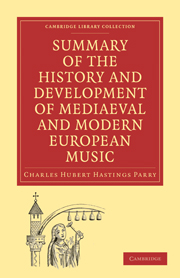Book contents
- Frontmatter
- PREFACE
- Contents
- CHAPTER I THE MUSIC OF THE MIDDLE AGES
- CHAPTER II MUSIC IN ENGLAND FROM THE BEGINNING OF TUDOR TIMES TILL THE RESTORATION OF THE STUARTS
- CHAPTER III THE BEGINNINGS OF OPERA AND ORATORIO
- CHAPTER IV THE PROGRESS OF OPERA IN VARIOUS COUNTRIES, FROM THE MIDDLE OF THE SEVENTEENTH CENTURY TILL THE TIME OF GLUCK
- CHAPTER V ORATORIO IN THE TIME OF BACH AND HANDEL
- CHAPTER VI THE PROGRESS OF INSTRUMENTAL MUSIC UP TO THE TIME OF J. S. BACH
- CHAPTER VII THE PROGRESS OF INSTRUMENTAL MUSIC IN THE EIGHTEENTH CENTURY
- CHAPTER VIII OPERA IN GLUCK AND MOZART'S TIME, AND IMMEDIATELY AFTER
- CHAPTER IX THE PROGRESS OF INSTRUMENTAL MUSIC TO BEETHOVEN AND HIS IMMEDIATE SUCCESSORS
- CHAPTER X MODERN INSTRUMENTAL MUSIC
- CHAPTER XI MODERN OPERA
- CHAPTER XII MODERN VOCAL MUSIC
CHAPTER VII - THE PROGRESS OF INSTRUMENTAL MUSIC IN THE EIGHTEENTH CENTURY
Published online by Cambridge University Press: 29 August 2010
- Frontmatter
- PREFACE
- Contents
- CHAPTER I THE MUSIC OF THE MIDDLE AGES
- CHAPTER II MUSIC IN ENGLAND FROM THE BEGINNING OF TUDOR TIMES TILL THE RESTORATION OF THE STUARTS
- CHAPTER III THE BEGINNINGS OF OPERA AND ORATORIO
- CHAPTER IV THE PROGRESS OF OPERA IN VARIOUS COUNTRIES, FROM THE MIDDLE OF THE SEVENTEENTH CENTURY TILL THE TIME OF GLUCK
- CHAPTER V ORATORIO IN THE TIME OF BACH AND HANDEL
- CHAPTER VI THE PROGRESS OF INSTRUMENTAL MUSIC UP TO THE TIME OF J. S. BACH
- CHAPTER VII THE PROGRESS OF INSTRUMENTAL MUSIC IN THE EIGHTEENTH CENTURY
- CHAPTER VIII OPERA IN GLUCK AND MOZART'S TIME, AND IMMEDIATELY AFTER
- CHAPTER IX THE PROGRESS OF INSTRUMENTAL MUSIC TO BEETHOVEN AND HIS IMMEDIATE SUCCESSORS
- CHAPTER X MODERN INSTRUMENTAL MUSIC
- CHAPTER XI MODERN OPERA
- CHAPTER XII MODERN VOCAL MUSIC
Summary
It is from the Italians that our modern style of instrumental music springs. Their inclination for simplicity of design and for easing the labour of attention seems to have led them, first of all people, to cultivate those simple kinds of harmonic contrast upon which the whole system of modern instrumental music rests. The contrapuntal style of art which culminated in the works of Bach and Handel was full of vigour and variety, but it showed signs of being toned down into more easy and obvious moods, in the choral works of even such early Italian masters as Leo, Durante, and Colonna; and this tendency is shown in a more marked degree in instrumental works such as the Concertos of Vivaldi. Early in the eighteenth century composers of Italian operas and of Italian instrumental music moved in the same direction. The writers of operas simplified their airs to the utmost to satisfy the taste of their indolent audiences. They made them as much as possible on one uniform pattern, in which simple contrast of the harmonies of tonic and dominant was essential to success; and they planned their overtures and preliminary symphonies on much the same principles. The great school of Italian violinists, whose artistic aims were much higher and nobler, were insensibly drawn in the same direction, and conveyed their ideas more and more in uniform harmonic designs. Some of them introduced allemandes and gigas, and other movements more characteristic of suites, into their sonatas, but even these soon became more and more harmonic in character and more distinctly uniform in plan.
- Type
- Chapter
- Information
- Publisher: Cambridge University PressPrint publication year: 2009First published in: 1893



